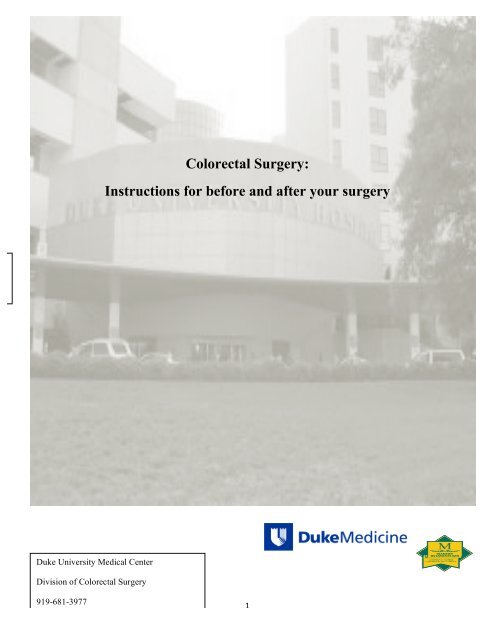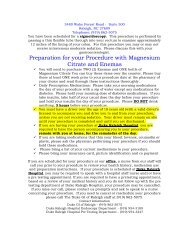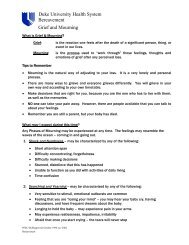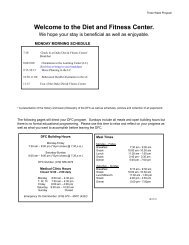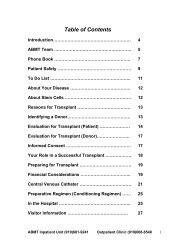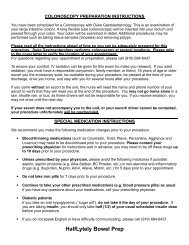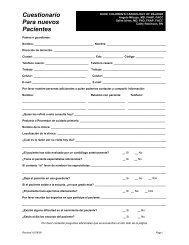Colorectal Surgery - Duke University Medical Center
Colorectal Surgery - Duke University Medical Center
Colorectal Surgery - Duke University Medical Center
Create successful ePaper yourself
Turn your PDF publications into a flip-book with our unique Google optimized e-Paper software.
<strong>Colorectal</strong> <strong>Surgery</strong>:<br />
Instructions for before and after your surgery<br />
<strong>Duke</strong> <strong>University</strong> <strong>Medical</strong> <strong>Center</strong><br />
Division of <strong>Colorectal</strong> <strong>Surgery</strong><br />
919-681-3977 <br />
1
This information is to help you understand:<br />
• The surgery that you are about to undergo<br />
• What you can expect during your hospital stay<br />
• What you can expect when you return home<br />
Please read over this information. Feel free to talk about these matters with the doctors,<br />
ostomy nurses or nurse practitioner. This booklet should give you a general idea of things<br />
to do to help you get well after your surgery.<br />
My Ostomy nurse is:<br />
and can be contacted at:<br />
I can contact Dr. at Monday-Friday 9:00 am – 5:00 pm<br />
After hours and weekends please call 919-684-8111 and ask for the surgical resident on call to<br />
be paged.<br />
IMPORTANT PLEASE READ<br />
2
Information provided by this pamphlet is for educational purposes. It is not intended to replace the advice or<br />
instruction of a professional healthcare practitioner, or to substitute medical care. Contact a qualified healthcare<br />
practitioner if you have any questions concerning your care<br />
TABLE OF CONTENTS<br />
Digestive Function . . . . . . . . . . . . . . . . . . . . . . . . . . . . . . . . . . . . . . . . . . . . . . . 4<br />
Hemicolectomy . . . . . . . . . . . . . . . . . . . . . . . . . . . . . . . . . . . . . . . . . . . . . . . . . 5<br />
Tansverse Colectomy and <strong>Colorectal</strong> anastamosis. . . . . . . . . . . . . . . . . . . . . . . 6<br />
Abdominal perineal resection and Low anterior resection. . . . . . . . . . . . . . . . . 7<br />
Low anterior resection and proctocolectomy . . . . . . . . . . . . . . . . . . . . . . . . . . . 8<br />
Ileocolic anastamosis . . . . . . . . . . . . . . . . . . . . . . . . . . . . . . . . . . . . . . . . . . . . . 9<br />
What is an ileostomy . . . . . . . . . . . . . . . . . . . . . . . . . . . . . . . . . . . . . . . . . . . . . .10<br />
What is a colostomy . . . . . . . . . . . . . . . . . . . . . . . . . . . . . . . . . . . . . . . . . . . . . . 11<br />
What can I expect before my surgery . . . . . . . . . . . . . . . . . . . . . . . . . . . . . . . . . 12<br />
Bowel preparation . . . . . . . . . . . . . . . . . . . . . . . . . . . . . . . . . . . . . . . . . . . . . . . .14<br />
What can I expect after my surgery . . . . . . . . . . . . . . . . . . . . . . . . . . . . . . . . . . 15<br />
What can I expect when I get home . . . . . . . . . . . . . . . . . . . . . . . . . . . . . . . . . . 17<br />
When should I call the doctor . . . . . . . . . . . . . . . . . . . . . . . . . . . . . . . . . . . . . . .19<br />
Changes in bowel function after colorectal surgery . . . . . . . . . . . . . . . . . . . . . .20<br />
How to adjust the dose of loperamide . . . . . . . . . . . . . . . . . . . . . . . . . . . . . . . . 23<br />
Ostomy internet resources . . . . . . . . . . . . . . . . . . . . . . . . . . . . . . . . . . . . . . . . . 24<br />
Learning to live with an ileal J-pouch . . . . . . . . . . . . . . . . . . . . . . . . . . . . . . . . 25<br />
3
Digestive Function<br />
Let us look at the normal digestive system so you can understand the type of surgery you are<br />
having.<br />
Food travels to the belly through a long tube called the esophagus. Enzymes in the belly break<br />
the food into smaller pieces. By the time the food has moved into the small intestine, it is<br />
mostly liquid. The small intestine absorbs the nutrients from this liquid. What is not needed<br />
passes into the large intestine (the colon). The primary function of the colon is to absorb water<br />
and make the waste (stool) more solid. Some vitamins are absorbed in the colon. Stool then<br />
passes through your rectum and out of your body through your anus.<br />
4
Your surgeon has told you that you need to have surgery on your bowel or rectum. This surgery<br />
could involve your small or large intestine or rectum. Some types of surgery that you may have<br />
include:<br />
Right or left hemicolectomy (remove the right or left part of your colon)<br />
Segmental resection (remove a section of your colon)<br />
5
Transverse colectomy (remove the transverse part of your colon)<br />
<strong>Colorectal</strong> anastomosis or reconstruction (remove part of your colon and join it to your rectum)<br />
6
Abdominal perineal resection (APR) with colostomy (remove part of your colon, all of your<br />
rectum and anus)<br />
7
Low anterior resection with coloanal anastomosis and J pouch construction (remove part of<br />
your rectum and make an area to replace it (J pouch construction)<br />
Proctocolectomy (remove your rectum or all or part of your colon)<br />
8
Ileocolonic anastamosis<br />
Sometimes your doctor may be able to join the good sections of your bowel or rectum together<br />
after the diseased part has been removed (anastomosis). Sometimes your doctor may have to<br />
bring a portion of your bowel out to your belly so that you can get rid of body wastes in this<br />
way (ostomy).<br />
9
What is an ostomy<br />
An ostomy is a surgical procedure that makes an opening (stoma) in your belly for the<br />
elimination of body wastes. You can have an ostomy for urinary or bowel problems. The type<br />
of ostomy that you have will depend upon which body part is affected: urine (urostomy), small<br />
bowel (ileostomy) or colon (colostomy).<br />
What is an ileostomy<br />
This is an opening (stoma) in your belly where the surgeon has brought a part of your small<br />
bowel to the outside. An ileostomy may be temporary or permanent.<br />
10
What is a colostomy<br />
This is an opening (stoma) in your belly where the surgeon has brought a part of your colon to<br />
the outside. The location of the stoma on your belly depends on what part of the colon is<br />
removed. A colostomy may be temporary or permanent.<br />
11
What can I expect before my surgery<br />
Once you have a date for your surgery, you can expect:<br />
• You may be given an appointment to be seen for a visit at <strong>Duke</strong> South Clinic 2D before<br />
your surgery or get a phone call<br />
• At this appointment or phone call, someone will look at your past medical history and the<br />
medicines that you take now. Please bring all of your medicines that you take with you to<br />
this appointment<br />
• You may be told that you will need some blood work , Xrays or see a special doctor like<br />
a Cardiologist (heart doctor) or Pulmonologist (lung doctor) before your surgery<br />
• You will be told what you need to do on the day of your surgery and where you need to<br />
go on the day of your surgery<br />
• You will be told what changes you may need to make in your diet before your surgery<br />
• You may meet with someone from anesthesia who will discuss with you the way that will<br />
be used to help control your pain during your surgery<br />
12
• You will be told what medicine, if any, you can take with small sips of water on the day<br />
of your surgery. Do not take any medicines except what you are told to take on the day of<br />
your surgery<br />
• If you take blood thinners, like aspirin, naproxen, ibuprofen, clopridogrel (Plavix®),<br />
warfarin (Coumadin®) or Pradaxa®, you will be told when you must stop them before<br />
your surgery. If you take any of these medicines and no one has mentioned when<br />
before your surgery<br />
to stop taking them, please ask your doctor’s office about them<br />
• On the day of your surgery, you may be given a 20 ounce bottle of Gatorade to drink<br />
about 30 minutes before your surgery<br />
13
Bowel Prep before your surgery<br />
Only take if directed by your doctor’s office to do this prep<br />
Purchase these over the counter laxatives:<br />
1. GATORADE (64 ounces) of lemonade or other CLEAR Gatorade (two 32 oz. bottles).<br />
2. DULCOLAX 5mg tablets (four tablets)<br />
3. MIRALAX BOTTLE 238 grams (medium size, over the counter only)<br />
The DAY BEFORE your colon surgery:<br />
Clear Liquids ONLY<br />
No Solid Food<br />
Examples of CLEAR LIQUIDS:<br />
Water, clear fruit juices such as apple or white grape, chicken or beef bouillion,<br />
jello (no RED or PURPLE), clear Gatorade, popsicles (No RED or PURPLE), clear<br />
soft drinks, coffee without cream or sugar.<br />
NO MILK OR MILK PRODUCTS, NO ORANGE JUICE,<br />
NO RED OR PURPLE JELLO OR JUICES.<br />
2 PM: Drink 8 ounces of clear liquids<br />
3 PM: Take 2 DULCOLAX tablets<br />
4 PM: Drink 8 ounces of clear liquids<br />
5 PM: Mix the entire bottle of MIRALAX into the 64 ounces of GATORADE. (Put half the<br />
bottle in each 32 ounce bottle). Shake the solution until fully dissolved. Drink an 8 ounce glass<br />
every 15 minutes until the solution is gone.<br />
7 PM: Take the last 2 DULCOLAX tablets.<br />
8 PM & 9 PM: Drink 8 ounces of clear liquids.<br />
• If you develop discomfort or bloating, stop drinking the solution for 30 minutes then<br />
restart the prep. Nausea, cramping, and abdominal fullness are the most common adverse<br />
reactions with the bowel prep.<br />
NOTHING BY MOUTH AFTER MIDNIGHT<br />
The DAY OF your colon surgery:<br />
You may take the medicines you were told to take with a sip of water but nothing to eat or drink<br />
14
What can I expect after surgery<br />
When you wake up in the Recovery Room (PACU) you can expect:<br />
• A needle in your hand that will drip fluids into your veins (an IV).<br />
• Pads on your chest and be connected to a monitor that will check your heart rate<br />
• A monitor on one of your fingers that will see how well you are circulating the oxygen<br />
that you breathe in.<br />
• To spend at least one hour in the PACU and then move to your room on the nursing unit.<br />
• If you received an ostomy, you will have a pouch (appliance) over it. It is normal to see<br />
some bloody drainage in the bag.<br />
• You may have a dressing over your incision that hooks to another machine. This<br />
machine works like a vacuum. It keeps the normal fluids that accumulate after surgery<br />
from causing a seroma (fluid collection).<br />
• You will have a tube into your bladder to drain the urine. This tube may stay in for<br />
several days after your surgery.<br />
15
• You will be out of bed on the night of your surgery. You should be walking in the halls<br />
of your nursing unit the day after your surgery. You should be out of your bed more than<br />
you are in your bed during your stay.<br />
How will you control my pain<br />
• You may have a needle in your back that will administer pain medicine to you (an<br />
epidural catheter)<br />
• You may receive some pain medicines through your IV line.<br />
• Before you leave, you will start on the pain medicines that you will take by mouth when<br />
you go home<br />
What will I get to eat<br />
• The day of your surgery, you can have ice chips or clear liquids.<br />
• You can have a regular diet (post surgical bland) by the time you go home.<br />
• Your diet should avoid foods that are high roughage foods such as lettuce and beans for<br />
four weeks after your surgery. Your diet should also avoid foods that are spicy or fried<br />
for four weeks after surgery. You should have softer meats such as<br />
chicken, fish or ground beef rather than harder meats like steak or pork chops for four<br />
weeks after your surgery<br />
16
Will I have to eat certain foods after my surgery<br />
• If you have had an ileostomy, you may have to avoid some foods for a while that may<br />
cause stool to back up. Your ostomy nurse will give you a list of these foods after your<br />
surgery.<br />
• If you have had a colostomy, you may want to avoid some foods that may cause gas or<br />
odor. Your ostomy nurse will give you a list of these foods after your surgery.<br />
What can I expect when I get home<br />
• BLEEDING<br />
o It is normal to have some old bloody discharge or sometimes stool coming from<br />
your rectum after this surgery in the first few days.<br />
o Your ostomy should be moist and red or pink in color.<br />
o If you have had an ostomy, it is normal for there to be some bleeding, especially in<br />
the first few days after surgery.<br />
o If you had an ileostomy, it is normal to have a high output several days after your<br />
surgery<br />
• STOOL OUTPUT:<br />
o You may be sent home from the hospital before you had your first stool after<br />
surgery. This should happen within a few days after you go home. If you stop<br />
passing gas from your bottom, or don’t have stool pass from your bottom within<br />
three days of being sent home, call the doctor’s office to find out if they wish to<br />
have you do something else.<br />
o For both an ileostomy and a colostomy, you may have liquid stools coming from<br />
your ostomy at first.<br />
o The stool from a colostomy will become paste-like sooner than from the ileostomy.<br />
17
• ACTIVITY:<br />
o You should get up and walk around the house several times a day. If it feels good,<br />
then do it! You may go up and down stairs as needed<br />
o No lifting anything heavier than 10 pounds (about 1 gallon of milk) for 6 weeks<br />
after surgery<br />
o No soaking in water (no swimming, no baths, and no hot tubs) until your doctor<br />
says that it is ok for you to do this. You may take a shower. Lightly<br />
pat dry any incision that you may have.<br />
o No driving as long as you are taking anything for pain stronger than Tylenol<br />
(acetaminophen)<br />
• WOUND CARE:<br />
o If you have an incision, you may notice a small amount of fluid draining from<br />
between your staples/sutures. It is ok if it remains the color of a light beer or light<br />
pink. Call your doctor and let them know if this happens and they will tell you if<br />
you should do something else.<br />
o Staples will come out about two (2) weeks after your surgery. You may have an<br />
appointment made to see your doctor’s nurse before you leave the hospital. If you<br />
live very far away, you may also have your family doctor or the home health nurse<br />
remove these staples/sutures. If no one discussed this with you before you left the<br />
hospital, please call your doctor’s office to set this up.<br />
o If you go home with an open incision, you will learn how to care for this incision<br />
before you leave the hospital. You may be able to have Home Health Services<br />
come into your home to help you. Someone will discuss this with you before you<br />
leave the hospital.<br />
18
When should I call the doctor<br />
• BLEEDING:<br />
o It is not normal to have bright red bleeding in large amounts coming from your<br />
ostomy or old dark blood from your rectum that continues beyond a few days.<br />
o You should let your doctor know if this happens.<br />
• STOOL OUTPUT:<br />
o It is not normal to have several loose stools from your rectum in a day several days<br />
in a row. Please call your doctor’s office if this happens.<br />
o If you have started taking imodium because of high output from your ileostomy,<br />
you should be concerned if the output from your ostomy remains greater than 1.5<br />
liters in a day. Call your doctor’s office.<br />
• DEHYDRATION:<br />
Sometimes after surgery, you may take in less food and fluids than you need. If you<br />
notice the following, call your doctor.<br />
o Your tongue and mouth are dry<br />
o You are not going to the bathroom during the day as much as you were<br />
o You feel dizzy when you stand up or you cannot think clearly<br />
• SUDDEN NEW ABDOMINAL PAIN:<br />
o If your pain worsens and the pain medicine that you have been taking does not<br />
manage your pain, please notify your doctor’s office<br />
• WOUND:<br />
o If you notice any cream colored, green or yellow drainage coming from your<br />
wound or a foul smell or redness and tenderness around the outside of your<br />
incision, please notify your doctor’s office.<br />
19
Changes in Bowel Function after <strong>Colorectal</strong> <strong>Surgery</strong><br />
How will my bowel function change after surgery<br />
You may have:<br />
• Loose stools, leakage of stool<br />
• More frequent urges to have a bowel movement (BM)<br />
• Trouble completely emptying your rectum<br />
• A strong desire to have a BM while eating<br />
These symptoms can be worse if you have had bowel radiation treatments.<br />
Why is this happening<br />
• Reduced length or absence of colon after surgery causes faster transit time<br />
• Decreased intestinal surface for absorbing fluids<br />
• Decreased capacity of rectum or surgically created pouch<br />
• Eating and drinking stimulate the gastrocolic reflex<br />
How long does it take for bowel function improves<br />
You may see improvement in the first few months after surgery. For others it may take up to a<br />
year.<br />
What can I do to help<br />
Do not avoid eating or drinking in hopes of preventing problems. This will only complicate<br />
your recovery.<br />
1. Firm up your stool. These foods help make the stool firmer and less frequent.<br />
• bananas, applesauce<br />
• cheese<br />
• boiled white rice<br />
• tapioca pudding<br />
• creamy peanut butter<br />
• white potatoes<br />
• white pasta<br />
• pretzels<br />
• marshmallows<br />
20
Which Foods Make Stool Softer and More Frequent<br />
• green leafy vegetables<br />
• fruit and vegetable peels<br />
• fruit juice<br />
• spicy or greasy food<br />
• beer and red wine<br />
• chocolate<br />
• caffeinated beverages<br />
• sorbitol and mannitol artificial sweeteners<br />
Which foods may contribute to anal irritation<br />
• certain raw fruits and vegetables (e.g. oranges, apples, coleslaw, celery and corn)<br />
• popcorn<br />
• chinese/oriental vegetables<br />
• nuts<br />
• coconut<br />
• dried fruits (e.g. raisins, figs)<br />
• foods with seeds<br />
• spicy foods<br />
• coffee and tea<br />
2. Include soluble fiber that can firm up and slow down stool.<br />
Examples:<br />
• Oats, barley, and rye<br />
• Lentils, kidney beans, and chickpeas<br />
Start with 1 teaspoon of a single product below. Slowly increase dose until stool firms<br />
up. Drink the recommended amount of water with it.<br />
• Psyllium husks (e.g. Metamucil)<br />
• Methylcellulose (e.g. Citrucel)<br />
• Wheat dextrin (e.g. Benefiber)<br />
3. Avoid drinking large amounts of hot or cold liquids very quickly or with meals. Get your<br />
daily fluid intake by drinking smaller amounts of cool fluids in between meals throughout<br />
the day and evening.<br />
21
4. Ask your doctor about antidiarrheal medicines such as Imodium or Lomotil. These<br />
are taken about 30 minutes before meals and at bedtime.<br />
5. Empty your bowels correctly<br />
• Hold off going to the toilet until the urge is very strong.<br />
• If you have to sit and wait, you sat down too soon.<br />
• Keep your knees higher than your hips (unless you just had hip surgery – check<br />
with your MD). Point your toes to raise your knees.<br />
• Lean forward with your elbows on your knees.<br />
• Do not strain. This weakens your pelvic floor muscles.<br />
6. Avoid heavy lifting, squatting, or intense physical activity while your stool is liquid to<br />
avoid leakage.<br />
7. Practice pelvic floor muscle exercises to strengthen your anal sphincter.<br />
• Begin by doing the exercises lying down with your feet elevated or your knees bent.<br />
Later you can do the exercises sitting and standing as well.<br />
• Tighten the muscles you would use if you were trying to hold your urine or stop from<br />
passing gas. You should have a sensation of lifting these muscles up and then relaxing<br />
to let them go down.<br />
• Do not tighten your abdominal muscles or your buttocks at the same time.<br />
• Tighten the muscle and hold for a count of 5, work up to a count of 10.<br />
• Relax the muscles slowly and completely. Rest for a count of 3.<br />
• Repeat the tightening and relaxing. Start with a set of 5 repetitions and work up to 10<br />
repetitions.<br />
• Start slowly and increase gradually to avoid overstressing the muscles.<br />
22
How to Adjust the Dosage of Loperamide<br />
Start this if your ostomy output is greater than 1200 ml<br />
What is loperamide<br />
• Loperamide is an anti-diarrhea drug that can be used to slow down the output from an<br />
ileostomy.<br />
• It is an over-the-counter drug.<br />
• It is also know by the brand name Imodium® but the store brand may be less expensive.<br />
How do I take it<br />
1. Start with one 2 mg pill before breakfast, lunch, dinner, and at bedtime<br />
2. Measure your stool for 24 hours<br />
3. If the total output is still more than 1200 ml, take two 2 mg pills before breakfast, lunch,<br />
dinner, and at bedtime<br />
• Never take more than 8 pills (or 16 mg) in 24 hours<br />
• You can reduce the amount of pills you take once your output is below 1200 ml per day<br />
How much does this drug cost<br />
• The cost of this medicine should be less than $20.<br />
• This medicine may not paid for by insurance, Medicare or Medicaid<br />
• Let your doctor or ostomy nurse know if you cannot afford this drug.<br />
What if my output stays more than 1200 ml per 24 hours while taking 8 pills a<br />
day<br />
• Call your surgeon<br />
23
Ostomy Internet Resources<br />
What are websites that can tell me about my ostomy and supplies<br />
• ConvaTec: Information and support. http://www.convatec.com/en/cvtus-ostomyus/cvtportalhpo/0/portalacc/1961/1433/0/ostomy.html<br />
• Coloplast: http://www.coloplast.com/Pages/home.aspx<br />
• Hollister: Information and support. Click on any of the topics in the learning center.<br />
http://www.hollister.com/<br />
• Great Comebacks: A program which recognizes inspirational people with ostomies.<br />
http://www.greatcomebacks.com/<br />
• Nu-Hope: http://nu-hope.com/<br />
How can I order ostomy supplies through the mail<br />
• Byram Health Care: http://www.byramhealthcare.com/<br />
• Edgepark Surgical Supplies: https://www.edgepark.com/<br />
• Liberty <strong>Medical</strong> Supplies: http://www.libertymedical.com/ostomy-supplies<br />
How can I locate a support group<br />
• Crohn’s, Colitis and Ostomy Meeting Place: http://www.ccomp.org/<br />
• Evansville Ostomy News: http://www.ostomy.evansville.net/<br />
• The International Ostomy Association: http://www.ostomyinternational.org/<br />
• Triangle Ostomy Association: http://www.raleighuoa.org/<br />
• United Ostomy Associations of America, Inc:<br />
http://www.uoaa.org/supportgroups.shtml<br />
• Bladder Cancer Advocacy Network: http://www.bcan.org/<br />
• Bladder Cancer Web Café: http://blcwebcafe.org<br />
What are the names of some companies that offer special clothing<br />
• Options: Undergarments with built in ostomy support system. www.optionsostomy.com<br />
• Ostomy Secrets: Stylish underwear for both men and women who are wearing a pouch.<br />
http://www.ostomysecrets.com/<br />
• Yentls Secrets: Covering for any shape or brand of ostomy pouch in various colors.<br />
http://www.yentlssecrets.com/Home_Page.html<br />
An excellent 16 minute video on Living with an Ostomy can be viewed at:<br />
http://www.ostomy.org/living_with_an_ostomy.shtml<br />
24
This page is only for people who have a J-pouch<br />
Learning to Live with your Ileal J-pouch<br />
What can I expect at first<br />
• At first you may have up to 15 small bowel movements (BM) a day.<br />
• You may have some leakage and need to get up several times at night.<br />
• You may have trouble telling the difference between gas and stool.<br />
What can I expect later on<br />
• Eventually, most patients have about 6 BMs daily, do not have significant leakage, and<br />
are not troubled by night time incontinence.<br />
• It may take up to a year to train your Ileal J-pouch.<br />
• You may need to take anti-diarrheal medicine (Imodium or Lomotil).<br />
• 95% of patients are very satisfied with their choice of an ileal J-pouch after a year.<br />
What can I do to help<br />
• Practice Pelvic Muscle Exercises to help your J-pouch hold stool without leaking (see<br />
Page 4).<br />
o Start practicing before surgery<br />
o Ask your surgeon when you can resume the exercises after your surgery.<br />
• Perform Perianal Skin Care to prevent skin irritation.<br />
o Gently cleanse and pat dry skin thoroughly at least once a day.<br />
o Use pH-balanced skin cleanser and warm water.<br />
o Alcohol-free moist wipes or soft tissues are ideal for cleansing and are less<br />
abrasive than toilet paper.<br />
o Use of a barrier product is essential to protect perianal skin.<br />
§ An ointment with petrolatum, dimethicone, or zinc oxide.<br />
• It is not necessary to clean it all off after each bowel movement.<br />
Remove only the soiled layer and apply a fresh coat on top.<br />
§ Or an alcohol-free barrier film wipe (e.g. 3M Cavilon)<br />
• One application will last 24 hours<br />
o Pads or panty liners should be changed frequently to keep skin clean and dry.<br />
• Train your pouch<br />
o You should not respond to every urge to have a BM. This will help to increase the<br />
size of the J-pouch. Start by waiting a few minutes. Build up to waiting an hour.<br />
o You can also help to control pouch function with diet and, if your doctor agrees,<br />
anti-diarrhea medication.<br />
25
What is Pouchitis<br />
• Pouchitis is a poorly understood inflammation of the J-pouch.<br />
• A small number of patients will experience this.<br />
• Symptoms include:<br />
• Feeling that you constantly need to have a BM<br />
• Diarrhea<br />
• Pelvic pain<br />
• Bloody stools<br />
• Fever<br />
• Loss of appetite<br />
• Feeling weak and tired<br />
How is it treated<br />
• Your doctor may use medications such as:<br />
• Antibiotics<br />
• Steroids<br />
• Non-steroidal anti-inflammatory drugs<br />
• Probiotics powder<br />
• If you have multiple episodes of pouchitis, your doctor may recommend regular pouch<br />
irrigation<br />
26
Pelvic muscle exercises<br />
Please do not start these exercises until your doctor says it is ok<br />
Why do I need to do these exercises<br />
• You will use these muscles after surgery to help you to hold your stool, especially when<br />
you stand up, cough, or sneeze.<br />
How often should I do the exercises<br />
• Do these exercises 3 times a day until you have good control of your urine during the day<br />
and night.<br />
How do I find the correct muscle<br />
• Tighten the muscles you would use if you were trying to hold your urine or stop from<br />
passing gas. You should have a sensation of lifting these muscles up and then relaxing to<br />
let them go down.<br />
• Do not tighten your abdominal muscles or your buttocks at the same time.<br />
What position should I be in<br />
• Begin by doing the exercises lying down with your feet elevated or your knees bent.<br />
• Later you can do the exercises sitting and standing as well.<br />
How do I do the exercises<br />
• Tighten the muscle and hold for a count of 5 seconds, work up to a count of 10.<br />
• Relax the muscles slowly and completely. Rest for a count of 3.<br />
• Repeat the tightening and relaxing. Start with a set of 5 repetitions and work up to 10<br />
repetitions<br />
• Start slowly and increase gradually to avoid overstressing the muscles.<br />
27


